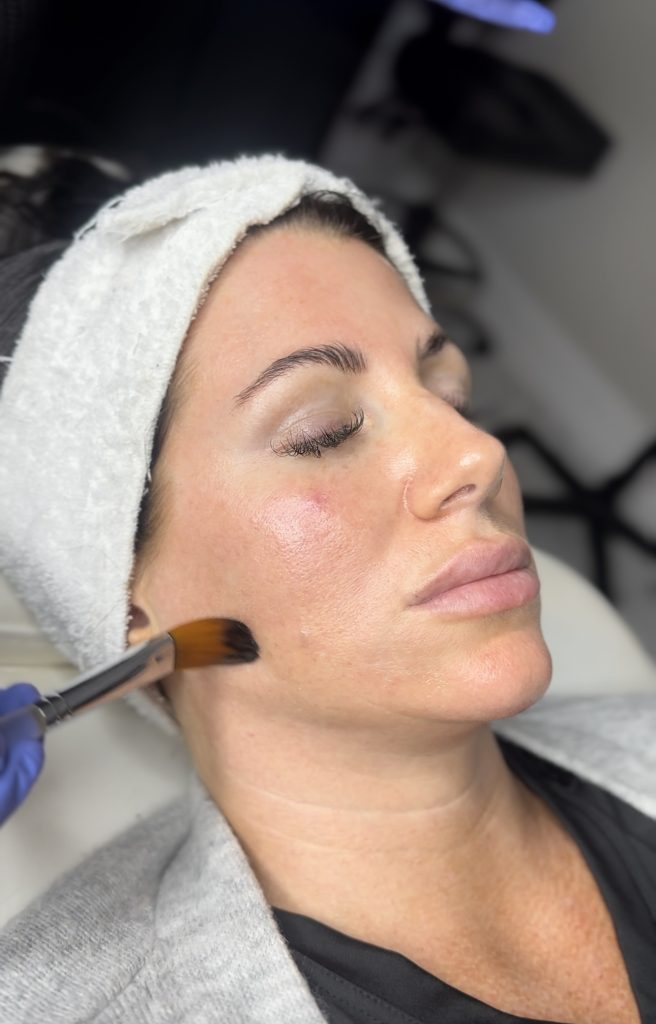Chemical Peels
Uncover a glowing complexion by reducing fine lines, wrinkles, sun damage, and acne with Chemical Peels. Suitable for all skin types, our Chemical Peels can be customized to address your unique concerns.
Superficial to deep peels
VI Peels
VI Peels remove the outer layers of skin to reveal healthier skin beneath. The chemical solution gently exfoliates damaged and dull layers, addressing imperfections and signs of aging, such as lines and wrinkles.

VI Peels are ideal for adults with:
- Sun Damage
- Melasma
- Hyperpigmentation
- Acne Scarring
- Discoloration
- Oily Skin
- Break-out Prone Skin
- Wrinkles and Fine Lines
- Sensitive Skin

Types of VI Peels
Original Tone & Texture
For first-time clients and sensitive skin (ages 20+). Formulated to rejuvenate, refresh, and reset for rapid, visible results safely and effectively.
Advanced Collagen Stimulation
For advanced aging signs (ages 40+). Penetrates deeply to address signs of aging and smooth fine lines and wrinkles, this specialized formula promotes collagen production, boosts cell turnover, and helps firm the skin.
Precision Plus Skin Discoloration
Targets discoloration and sun damage. This medium-depth powerhouse peel targets melanin production to reduce dark spots and accelerates cell turnover, revealing a brighter, even skin tone within 7 days.
Purify Active Acne & Oily Skin
Designed for oily, acne-prone skin. Clear out oil, acne, and balance skin for improved texture and fewer breakouts.
Purify with Precision Plus
For oily skin with acne and hyperpigmentation. This advanced acne treatment clears breakouts and prevents future issues while reducing post-acne scars and uneven skin tone for a brighter, smoother complexion.
Medium Depth
Glow Peels
AlumierMD® “Glow Peel” is a medium-depth, medical-grade peel that combines lactic acid, salicylic acid, and resorcinol for effective resurfacing.
It’s ideal for addressing pigmentation, fine lines, wrinkles, age spots, post-pregnancy mask, and uneven skin tone! Expect some redness right after the procedure and minor peeling 3-5 days later.
Ideal Glow Peel Candidates
Glow Peels are ideal for adults in good health looking to improve:
- Fine Lines
- Wrinkles
- Hyperpigmentation
- Age Spots
- Discoloration
- Dull Skin
- Uneven Skin Tone

POST TREATMENT
Prep
To optimize your results, it’s essential to prep your skin accordingly. Please refrain from using retinoids, glycolic acid, salicylic acid, benzoyl peroxide, microneedling, sun exposure, and hair removal treatments for at least one week before your appointment.
Care
After your treatment, you’ll receive a post-care kit with instructions.
For best results, avoid washing or touching treated skin for a few hours, don’t apply makeup for at least 4 hours, and stay out of the sun for one week.
Also, avoid exfoliating products until peeling is complete.
Side Effects
VI Peels are known for being gentle and effective, causing minimal discomfort and self-neutralizing over time.
Some post-treatment redness is normal and can be managed with sunscreen.
FAQs
Chemical peels intentionally damage the epidermis and/or dermis to stimulate new tissue growth, enhancing skin texture and tone. This practice has ancient roots, dating back to Egypt, where Cleopatra reportedly used sour milk—rich in lactic acid, an alpha hydroxy acid—to improve her skin’s appearance.
They are classified into three types based on depth:
Superficial Peels: Target the outermost layer using mild acids (e.g., glycolic or lactic acid) for minor skin improvements with minimal downtime.
Medium Peels: Penetrate deeper, utilizing trichloroacetic acid (TCA) or stronger AHAs to treat moderate issues like sun damage and fine lines, requiring some recovery time.
Deep Peels: Reach the deeper dermis, using phenol or high concentrations of TCA to address severe concerns such as deep wrinkles and significant hyperpigmentation, necessitating longer recovery.
Chemical peels are a unique form of treatment for several reasons:
1. Controlled Exfoliation: They provide a precise method for removing damaged skin layers, allowing for tailored treatments based on individual skin conditions and goals.
2. Stimulated Regeneration: By intentionally damaging the skin, chemical peels stimulate collagen production and cell turnover, promoting the growth of healthier, more youthful skin.
3. Versatility: They can address a wide range of skin concerns, including acne, fine lines, sun damage, hyperpigmentation, and uneven texture, making them suitable for various skin types and issues.
4. Customizable Depths: Peels can be adjusted in strength and depth (superficial, medium, or deep) to target specific problems and accommodate different skin sensitivities and recovery needs.
5. Minimal Invasiveness: Unlike surgical procedures, chemical peels are non-invasive and can often be performed in an outpatient setting with relatively quick recovery times, especially for superficial peels.
6. Long-Lasting Results: With proper care, the effects of chemical peels can be long-lasting, providing significant improvements in skin quality and appearance over time.
These factors combine to make chemical peels a highly effective and sought-after treatment in aesthetic dermatology.
Depending on the strength, patients may feel a range of sensations from slight tingling to a more intense burning sensation. Superficial peels tend to feel milder compared to medium and deep peels. Redness and dryness can occur in patients with sensitive skin.
VI Peels
Yet another great thing about VI Peels is that they are self-neutralizing, which means they are generally painless as opposed to other chemical peel solutions on the market. For several days after the peel, your skin will likely appear red or flushed (like a mild sunburn). We recommend you apply sunscreen regularly in the days and weeks after your peel. Trust us on that one!
- Sensation: Mild to moderate tingling or burning during application, which usually subsides after a few minutes.
- Post-Peel: Some redness and sensitivity may occur, along with peeling that can last several days, but discomfort typically diminishes quickly.
Glow Peels
- Sensation: Generally, glow peels are milder and designed to refresh the skin, causing minimal discomfort. Patients may feel light tingling but usually not burning.
- Post-Peel: Expect slight redness and a smoother texture without significant peeling, making them popular for a quick refresh.
This a common question for our first timers, so here’s how it works: First, we’ll thoroughly cleanse your skin to get rid of any remnants of dirt or oil that may be there without you even knowing it. After that, we apply the peel solution that’s decided upon before your treatment that best suits your skin type and personal aesthetic goals. While the solution works its magic, you might feel some tingling or experience a bit of numbness depending on the solution that’s used. After it’s had some time to take its intended effect, the solution is then washed off.
With many peel formulas, your skin will generally peel over about three days following your treatment.
Chemical peels can be applied to the face, neck, décolleté, back and hands.
Superficial chemical peels work by lowering the pH, which loosens the connections between dead skin cells, promoting exfoliation and new cell growth. This reveals a smoother, more radiant complexion and can thicken the epidermis, increase dermal volume, and stimulate collagen production. They typically have minimal side effects, though hyperpigmentation can occur in darker skin types.
In contrast, medium and deep chemical peels induce protein coagulation and cell death in the epidermis and dermis, triggering inflammation and the wound-healing process, which leads to dermal regeneration and collagen stimulation. These peels require more downtime and carry a higher risk of side effects, including hyperpigmentation, hypopigmentation, infection, and scarring.
Common peeling agents include alpha hydroxy acids (AHAs) like glycolic, lactic, malic, tartaric, and mandelic acids, as well as beta hydroxy acid (salicylic acid) and trichloroacetic acid (TCA). Not all peels are suitable for every skin type; specific ingredients are more effective for conditions like acne, hyperpigmentation, or signs of aging.
Generally, superficial peels have a recovery period of about 3 to 7 days, while medium peels may require 1 to 2 weeks and deep peels can necessitate 2 to 3 weeks or more for full recovery.
1. Immediate Post-Peel Care: After the procedure, it is crucial to calm and protect the skin to minimize irritation and promote healing. The application of a specially formulated Recovery Balm is recommended. This balm is rich in antioxidants and peptides, designed to relieve redness and soothe the skin.
2. Sun Protection: Following a chemical peel, the skin becomes more sensitive to UV rays. Therefore, applying a broad-spectrum sunscreen, such as SPF 42 is essential.
3. Post Prescription Kit: To further support healing, a Post Prescription Kit may include: a gentle cleanser designed for post-peel skin, and additional sun protection while keeping the skin hydrated.
The recovery process following a chemical peel is critical for optimal results. By using specialized products, ensuring proper sun protection, and following a gentle skincare routine, patients can effectively manage side effects and enhance healing. This systematic approach not only promotes a smoother and more radiant complexion but also helps in achieving long-lasting benefits from the peel.
Ready To Get Started?
Ready to experience the transformative effects of a VI Peel? Schedule your consultation with Skin Esteem today by calling (833) 377-SKIN (7546). Unlock the secret to a radiant complexion and reveal your skin’s true potential!
